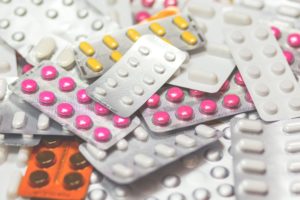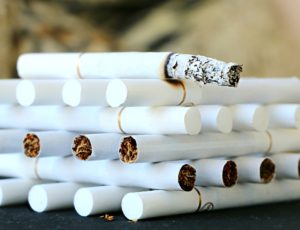What addiction is, how drugs become addictive by way of binding to the CB1 receptor, and how CBD can treat addiction.
Before discussing the mechanism by which CBD treats addiction, we should first understand what addiction is and how is it born.
What is addiction?
Addiction is when a drug, whether it be nicotine, opioids, alcohol, or heroin causes physical changes to the body resulting in the need to take progressively higher doses to get the same effect. Neurotransmitters in the brain are involved in the addiction process, the most excitatory one being glutamate. The other common ones are dopamine, serotonin, and norepinephrine.
How does addiction start? The person wants emotional or physical relief. The drug gives the user a pleasurable effect. That effect may be reduction of anxiety, pain relief, ability to focus, less sadness, or feeling “high”.
The addiction process begins when the drug binds to the CB1 receptor on the cell wall. This causes a change in the configuration of the CB1 receptor. If the drug is taken regularly, the CB1 receptor diminishes in quantity and the user then needs to take progressively higher doses of the drug in order to get the same pleasurable effect.
When the effects of the drug wane, the person begins to feel “down”. For example, if the drug helped you relax, when the effects wear off, you feel anxious. If the drug helped you sleep, when the effects wear off you have insomnia. If the drug made you “high”, when the effects wear off you feel “low”.
Next – the craving. In order not to experience these negative effects, or “withdrawal symptoms” such as anxiousness, restlessness, inability to concentrate, anger outbursts, paranoia, insomnia, digestive ailments, or depression you seek out the drug – but no longer for the pleasurable effect it may bring you, but rather in order to avoid the very uncomfortable withdrawal effects.
And so, addiction is born – the compulsive desire to seek and use drugs despite negative consequences.
General statistics about opioid, nicotine, and alcohol:
More Americans died of opioid overdose (opioid, heroin, fentanyl) in 2016 than died in the entirety of the Vietnam war, and more Americans died of opioid overdoses in 2017 than died of breast cancer.
The Centers for Disease Control and Prevention estimates that tobacco causes 6 million deaths per year. This makes tobacco the leading cause of preventable death, causing one of every five deaths in the United States each year.
Smokeless tobacco is a known cause of cancer. In addition, the nicotine in smokeless tobacco increases the risk for sudden death from a condition where the heart does not beat properly (ventricular arrhythmias).
Twenty five percent of people in the United States binge drink. One third of all driving fatalities are alcohol related. Alcohol is the third leading preventable cause of death (after cigarette smoking, and poor diet).
What do all theses addictive agents have in common?
- They all become addictive by way of binding to the CB1 receptor and
- They can all be treated by CBD.
How does CBD treat addiction and what is the biochemistry behind it?
CBD is a weak inverse agonist at the CB1 receptor site. When CBD binds to the CB1 receptor, it blocks the drugs which bind to CB1 from “getting you high”.
CBD stimulates TRVP1 and blocks the hydrolysis of AEA by inhibiting fatty acid amine hydrolase. The result: increased “bliss”.
CBD is an agonist of 5-HT1a serotoninergic receptor and allosterically modulates the μ and δ opioid receptors. The result: pain control and less anxiety. Decreasing the anxiety level is critical because this rises during the symptoms of withdrawal.
An added benefit of CBD – CBD protects glutamate toxicity – which is why it is so effective in the treatment of stroke and cardiovascular ischemia – but this will be discussed in another article.
How does CBD treat addiction?
CBD treats addiction by blocking the withdrawal symptoms as well as the “high” from the drugs of abuse. When both the symptoms of the withdrawal and reward are blocked, the addiction is controlled. As an added benefit, CBD has multiple unrelated benefits which include anxiety relief, stress reduction, decreased pain, control of migraines, an ability to focus, and a more restful sleep.
Not only does CBD treat the addiction, but you don’t need high doses of CBD to prevent the withdrawal or to treat the addiction. However, you do need 24/7 coverage – because when the “craving” is felt, the temptation is very hard to resist.
Reaching for a CBD vape when you feel the need to smoke or reaching for a tincture when you wish to “pop” a pill is a good start. However, taking a once-a-day CBD Softgels, may be the best way to keep yourself in a centered state 24/7 – and allow you to live your life at its best.
Take-home point: CBD gives one an emotional centering and feeling of bliss – which very often was what the drug user was seeking in the first place.
References:
UNODC. World Drug Report 2014. Vienna, Austria: United Nations Office on Drugs and Crime; 2014.
“Blunted psychotomimetic and amnestic effects of delta-9-tetrahydrocannabinol in frequent users of cannabis.” Neuropsychopharmacology. 2008;33(10):2505–16.
“Cannabidiol displays unexpectedly high potency as an antagonist of CB1 and CB2 receptor agonists in vitro.” Br J Pharmacol. 2007;150(5):613–23.
“The diverse CB1 and CB2 receptor pharmacology of three plant cannabinoids: delta9-tetrahydrocannabinol, cannabidiol and delta9- tetrahydrocannabivarin.” Br J Pharmacol. 2008;153(2):199–215.
“Agonistic properties of cannabidiol at 5-HT1a receptors.” Neurochem Res. 2005;30(8):1037–43.
“Cannabidiol is an allosteric modulator at mu- and delta-opioid receptors.” Naunyn Schmiedebergs Arch Pharmacol. 2006;372(5):354–61.
“Neurocircuitry of addiction.” Neuropsychopharmacology. 2010;35(1):217–38.
“Glutamate transmission in addiction.” Neuropharmacology. 2009;56(suppl 1):169–73.
“The mesolimbic dopamine system: the final common pathway for the reinforcing effect of drugs of abuse?” Neurosci Biobehavioral Rev. 2006;30(2):215–38.
“Modulation of the endocannabinoid system: vulnerability factor and new treatment target for stimulant addiction.” Front Psychiatry. 2013; 4:109.
“Endocannabinoid signaling system and brain reward: emphasis on dopamine.” Pharmacol Biochem Behav. 2005;81(2):263–84.
“The psychotomimetic effects of intravenous delta-9-tetrahydrocannabinol in healthy individuals: implications for psychosis.” Neuropsychopharmacology. 2004;29(8):1558–72.
“Anxiolytic effect of cannabidiol derivatives in the elevated plus-maze.” Gen Pharmacol. 1994;25(1):161–4.
“Antidepressant like effects of cannabidiol in mice: possible involvement of 5-HT1A receptors.” Br J Pharmacol. 2010;159(1):122–8.
“Cannabidiol, a Cannabis sativa constituent, as an antipsychotic drug.” Braz J Med Biol Res. 2006;39(4):421–9.
U.S. Department of Health and Human Services. “The Health Consequences of Smoking—50 Years of Progress: A Report of the Surgeon General.” Atlanta: U.S. Department of Health and Human Services, Centers for Disease Control and Prevention, National Center for Chronic Disease Prevention and Health Promotion, Office on Smoking and Health, 2014
“Endocannabinoid signaling and long-term synaptic plasticity.” Annu Rev Physiol. 2009; 71:283–306.
“Cannabidiol, a nonpsychotropic component of cannabis, inhibits cue-induced heroin seeking and normalizes discrete mesolimbic neuronal disturbances.” J Neurosci. 2009;29(47):14764–9.
“Cannabidiol inhibits the reward facilitating effect of morphine: involvement of 5-HT1A receptors in the dorsal raphe nucleus.” Addict Biol. 2013;18(2):286–96.
“Interactions between cannabidiol and delta9- THC during abstinence in morphine-dependent rats.” Life Sci. 1975;17(6):851–7.
“Differential effect of cannabinol and cannabidiol on THC-induced responses during abstinence in morphine-dependent rats.” Res Commun Chem Pathol Pharmacol. 1975;12(1):185–8.
“Effect of some cannabinoids on naloxone-precipitated abstinence in morphine-dependent mice.” Psychopharmacology. 1976;49(3):267–70.
“The quasi-morphine withdrawal syndrome: effect of cannabinol, cannabidiol and tetrahydrocannabinol.” Pharmacol Biochem Behav. 1985;23(1):13–5.
“Cannabidiol for the treatment of cannabis withdrawal syndrome: a case report.” J Clin Pharm Ther. 2013;38(2):162–4.
“Cannabidiol reduces cigarette consumption in tobacco smokers: preliminary findings.” Addict Behav. 2013;38(9):2433–6.
“Interaction of cannabidiol and alcohol in humans.” Psychopharmacology. 1979;66(1):45–50
“Antipsychotic effect of cannabidiol.” J Clin Psychiatry. 1995;56(10):485–6.
“Diminished gray matter in the hippocampus of cannabis users: possible protective effects of cannabidiol.” Drug Alcohol Depend. 2011;114(2–3):242–5.
“Long-term effects of marijuana use on the brain” Neuroscience : Proc Natl Acad Sci U S A. 2014 Nov 25; 111(47): 16913–16918.
“Transdermal delivery of cannabidiol attenuates binge alcohol-induced neurodegeneration in a rodent model of an alcohol us disorder.” Pharmacology Biochemistry& Behavior. Volume 111, October 2013, pgs. 120-127
“Cannabidiol reduces cigarette consumption in tobacco smokers: preliminary findings.” Addict Behav. 2013 Sep;38(9):2433-6.
“Cannabidiol, a nonpsychotropic component of cannabis, inhibits cue-induced heroin seeking and normalizes discrete mesolimbic neuronal disturbances.” J Neurosci. 2009 Nov 25;29(47):14764-9
“Tips from Former Smokers.” Center for Disease Control and Prevention. 2013 July 1
“Mortality in relation to smoking: 50 years’ observations on male British doctors.” BMJ. 2004;328:1519
“A Review of the Interactions between Alcohol and the Endocannabinoid System: Implications for Alcohol Dependence and Future Directions for Research.” Alcohol. 2012 May; 46(3): 185–204.
“SR141716, a central cannabinoid (CB1) receptor antagonist, blocks the motivational and dopamine-releasing effects of nicotine in rats.” Behavioural Pharmacology: September 2002 – Volume 13 – Issue 5 – p 451-463












